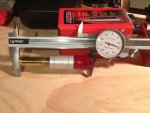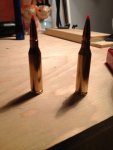Hello to you all.
Let me start by saying that I have been an active forum visitor over the years but this is the first time I actually registered. I consider my reloading experience as average since I have been at it for over 15 years loading different caliber. The question I have is more informal and for my own personal knowledge.
I bought a Savage LRP in 260 REM. I started loading for it already and these are my components.
Lapua 260 REM brass
H4350 Start 39.0g /End 42.0gr
Hornady 140gr Amax seated 2.790 inches
Federal 210 match primers
Now as to my questions. I know this topic has been hashed over and over the years but I could not find the answer I was looking for.
I have many boxes of once fired 308 Winchester brass that were given to me by a friend. Again, I will be using my Lapua for my reloading and this question is just for personal knowledge. If the Lapua brass gets hard to get in Canada or if perhaps the 260 REM goes out of style I want to be prepared. So yesterday, having to much time on my hands, I screwed in my RCBS full length die and applied Redding sizing wax outside and inside the necks of the 308 win brass. I resized a few cases in one pass without any apparent problems. Using my Hornady headspace gauge I compared headspace on the 308 win brass before and after the resize to make sure the shoulders were not pushed back.
Win 308 brass fired once in firends savage action. Datum line indicating 1.625 inches
Win 308 brass resized in the 260 die: Datum line indicating 1.627 inches
Lapua virgin brass. Datum line indicating 1.627 inches

Now I keep reading that the issues with necking down 308 win brass to 260 rem is the fact that part of the 308 neck becomes shoulder in the 260. The necks get thicker and need to be turned down as to allow enough clearance for neck expansion and bullet release without pressure going through the roof. So I measured virgin Lapua brass seated with the 140gr Amax using a standard caliper. The necks at the top measure on average .294 to .295 inches. As for the 308 Win brass that was resized to 260, the necks measure on average .291 to .292 inches.
260 Lapua case next to a 308 Win case resized to 260

So finally my questions are. Finally lol
1- Do I need to neck turn my brass? if I do, where?
2- If this resized brass chambers in my gun without any difficulty, would it be considered safe to shoot using starting loads and working my way up?
Please feel free to enlighten me. Like I said earlier, this is my first time necking down cases and I'm doing this to tinker around and learn more about necking down cases.
Regards,
Globalflyer
Let me start by saying that I have been an active forum visitor over the years but this is the first time I actually registered. I consider my reloading experience as average since I have been at it for over 15 years loading different caliber. The question I have is more informal and for my own personal knowledge.
I bought a Savage LRP in 260 REM. I started loading for it already and these are my components.
Lapua 260 REM brass
H4350 Start 39.0g /End 42.0gr
Hornady 140gr Amax seated 2.790 inches
Federal 210 match primers
Now as to my questions. I know this topic has been hashed over and over the years but I could not find the answer I was looking for.
I have many boxes of once fired 308 Winchester brass that were given to me by a friend. Again, I will be using my Lapua for my reloading and this question is just for personal knowledge. If the Lapua brass gets hard to get in Canada or if perhaps the 260 REM goes out of style I want to be prepared. So yesterday, having to much time on my hands, I screwed in my RCBS full length die and applied Redding sizing wax outside and inside the necks of the 308 win brass. I resized a few cases in one pass without any apparent problems. Using my Hornady headspace gauge I compared headspace on the 308 win brass before and after the resize to make sure the shoulders were not pushed back.
Win 308 brass fired once in firends savage action. Datum line indicating 1.625 inches
Win 308 brass resized in the 260 die: Datum line indicating 1.627 inches
Lapua virgin brass. Datum line indicating 1.627 inches

Now I keep reading that the issues with necking down 308 win brass to 260 rem is the fact that part of the 308 neck becomes shoulder in the 260. The necks get thicker and need to be turned down as to allow enough clearance for neck expansion and bullet release without pressure going through the roof. So I measured virgin Lapua brass seated with the 140gr Amax using a standard caliper. The necks at the top measure on average .294 to .295 inches. As for the 308 Win brass that was resized to 260, the necks measure on average .291 to .292 inches.
260 Lapua case next to a 308 Win case resized to 260

So finally my questions are. Finally lol
1- Do I need to neck turn my brass? if I do, where?
2- If this resized brass chambers in my gun without any difficulty, would it be considered safe to shoot using starting loads and working my way up?
Please feel free to enlighten me. Like I said earlier, this is my first time necking down cases and I'm doing this to tinker around and learn more about necking down cases.
Regards,
Globalflyer
Last edited:


